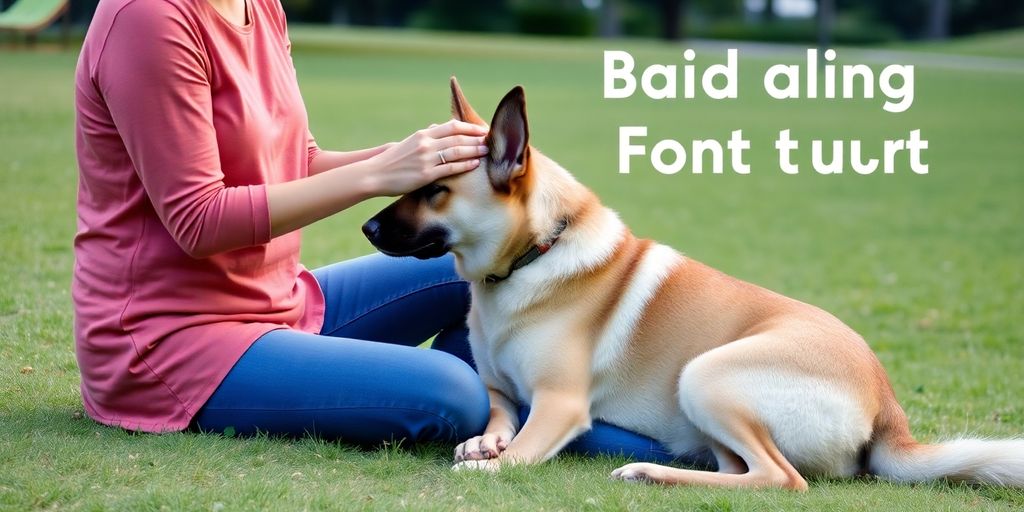Dealing with a dog that shows aggression towards you can be really stressful. Whether it's barking, growling, or even lunging, it’s not just scary but can also make you feel unsafe in your own home. Luckily, there are effective strategies to help manage and reduce this behavior. In this article, we’ll go through five practical methods on how to stop dog aggression towards me, so you can feel more secure and enjoy a better relationship with your furry friend.
Key Takeaways
- Seek help from a professional trainer for tailored behavior modification.
- Regularly socialize your dog with different people and environments.
- Use positive reinforcement to encourage good behavior and discourage aggression.
- Gradually expose your dog to their triggers in a controlled way.
- Maintain clear and consistent communication with your dog.
1. Professional Behavior Modification
Sometimes, you just need to bring in the pros, you know? If you're dealing with serious dog aggression, it might be time to consult a certified dog behaviorist or a professional trainer who specializes in aggression cases. It's not admitting defeat; it's about getting your dog the best help possible.
These experts can really dig deep to figure out what's causing your dog's aggression and create a plan that's tailored just for them. They'll assess your dog's specific triggers and behaviors, and then teach you how to safely manage things. Plus, they can give you ongoing support and tweak the plan as needed. Think of it as having a coach in your corner, guiding you and your dog toward a happier, safer life together. It's an investment, sure, but it can make a world of difference.
Getting professional help is a sign of strength, not weakness. It means you're committed to your dog's well-being and willing to do whatever it takes to help them overcome their aggression issues. Don't hesitate to reach out – it could be the best decision you ever make for your furry friend.
Before you commit, make sure they have experience with aggression cases and certifications from reputable organizations. Don't be afraid to ask questions or shop around – finding the right fit for you and your dog is super important. Remember, you're looking for someone who understands dog behavior and can communicate effectively with both you and your pup. It's all about teamwork!
2. Ongoing Socialization
Okay, so you're working on your dog's aggression. That's awesome! It's not a quick fix, but definitely doable. One of the biggest things you can do is keep up with socialization. It's not just for puppies! Adult dogs benefit big time, too. Think of it like this: the more good experiences your dog has, the less likely they are to react badly to new situations.
Socialization isn't just about throwing your dog into a crowd and hoping for the best. It's about carefully managed, positive interactions that build confidence and reduce fear.
Here's the deal: consistent, positive interactions are key. It's about making sure your dog learns that new people, places, and other animals aren't scary. It's a marathon, not a sprint, so be patient and celebrate the small wins. You got this!
Here are some ideas to get you started:
- Controlled Introductions: Start with one-on-one meetings in a neutral space. Keep it short and sweet. Think a quick sniff, then move on. No pressure!
- Group Walks: Once your dog is doing better, try group walks with other well-behaved dogs. This lets them get used to being around other dogs without having to directly interact.
- Dog-Friendly Events: Check out local dog-friendly events. Farmers markets, outdoor cafes, even pet store events can be great opportunities for exposure. Just make sure you can keep a safe distance if needed.
Remember, every dog is different. What works for one might not work for another. Pay attention to your dog's body language and adjust accordingly. If they seem stressed, back off and try again later. And don't forget the positive reinforcement techniques!
3. Positive Reinforcement Training
Okay, so positive reinforcement. It's not just about treats (though, let's be real, dogs love treats). It's about building a positive association with the behaviors you want to see. Think of it as rewarding your dog for making good choices. It's way more effective than yelling, trust me.
Positive reinforcement is all about rewarding good behavior, not punishing bad behavior. It's like, instead of getting mad when your dog jumps on you, you reward them when they sit nicely. It's a game-changer.
Here's a few things to keep in mind:
- Timing is everything. You gotta reward the behavior immediately after it happens. Like, within a second or two. Otherwise, they won't connect the reward with the action.
- Use high-value rewards. Figure out what your dog really loves. Is it a specific treat? A certain toy? Praise? Use whatever motivates them the most.
- Be consistent. Everyone in the house needs to be on board with the training. If one person lets the dog get away with something, it'll confuse them.
Positive reinforcement is a long game. It takes time and patience, but the results are so worth it. You'll end up with a happier, more confident dog who actually wants to listen to you. Plus, it strengthens your bond, which is always a good thing.
Think about teaching your dog to "leave it." If they're about to grab something they shouldn't, say "leave it" and then, if they listen, give them a tasty treat. Over time, they'll learn that "leave it" means good things happen. You can even use obedience training to help with this.
It's all about creating a positive and fun learning environment. Your dog will thank you for it!
4. Controlled Exposure to Triggers
Okay, so your dog has triggers, right? Things that set them off. The key here isn't to bubble-wrap them forever, but to introduce those triggers in a way that's super controlled and safe. Think of it like this: you're slowly showing them that the scary thing isn't actually that scary. It's all about baby steps and making sure they feel secure during the whole process. This is where you start to see real progress, and it's pretty awesome when it clicks!
Environmental Adjustments
First things first, let's talk about setting the stage. You can't just throw your dog into the deep end and expect them to swim. Start by managing their immediate environment. Maybe that means using window film to block the sight of the mailman (a classic trigger!), or choosing quieter walking routes. Think about what you can change to minimize unexpected encounters. It's like setting up a safe space for them to learn and adjust.
Gradual Introduction
This is where the controlled part really comes in. Let's say your dog hates other dogs. Don't just take them to a dog park! Instead, start with seeing another dog from a distance – like, across the street. If your dog stays calm, reward them! Slowly, over time, you can decrease the distance, always watching for signs of stress. If they get anxious, back off and try again later at a greater distance. Patience is key here, and it's totally worth it.
Creating Positive Associations
Okay, so your dog sees the trigger… now what? This is where you turn it into a positive experience. Every time they're exposed to the trigger (at a safe distance, of course), give them a treat, praise, or a favorite toy. The goal is to create a positive association with the thing they used to fear. Over time, they'll start to think, "Oh, the mailman? That means I get a yummy treat!" It's all about changing their emotional response to the trigger.
Remember, this isn't a race. Some dogs take longer than others, and that's totally okay. The most important thing is to be patient, consistent, and always prioritize your dog's safety and well-being. If you're feeling overwhelmed, don't hesitate to reach out to a professional trainer or behaviorist. They can provide personalized guidance and support.
5. Consistent Communication Techniques
Okay, so you've been working on all these strategies, but here's the thing: if you're not consistent, it's like speaking a different language to your dog every day. They get confused, and that can actually make aggression worse. Think of it like this: you wouldn't want someone changing the rules on you all the time, right? Same goes for your furry pal. Consistency is key to building trust and clear expectations.
Imagine trying to learn a new skill, but the instructions keep changing. Frustrating, right? That's how inconsistent communication feels to your dog. It can lead to anxiety and uncertainty, which can trigger aggressive behaviors.
Here's the deal:
"Unlock the Secrets to a Blissful, Healthier Puppy: Discover the Benefits of Holistic Housebreaking"
- Use the same commands every time. Don't switch between "sit," "down," and "settle" randomly. Pick one and stick with it.
- Make sure everyone in the house is on the same page. If you allow the dog on the couch but your partner doesn't, that's a recipe for confusion. Dog aggression solutions require a united front.
- Be consistent with your body language. Dogs are masters at reading our cues, so make sure your actions match your words. If you're saying "no" but your body language is hesitant, your dog will pick up on that.
It might seem like a small thing, but consistent communication can make a huge difference in managing and reducing dog aggression. You got this!
Wrapping It Up
So there you have it! Tackling dog aggression isn’t just a pipe dream. With a little patience and some solid strategies, you can make a real difference. Remember, it’s all about understanding your pup and giving them the right tools to feel secure and calm. Take it one step at a time, and don’t hesitate to reach out for help if you need it. You and your furry friend can totally turn things around and enjoy a happier, more peaceful life together. Here’s to a future filled with wagging tails and happy barks!
Frequently Asked Questions
What should I do if my dog shows aggression towards me?
If your dog is aggressive, it's important to stay calm and avoid punishing them. Instead, seek help from a professional dog trainer who specializes in behavior issues.
How can I improve my dog's social skills?
Regular socialization is key. Take your dog to parks, dog classes, or playdates with other friendly dogs to help them learn how to interact positively.
What is positive reinforcement training?
Positive reinforcement training means rewarding your dog for good behavior with treats, praise, or playtime. This encourages them to repeat those good behaviors.
How can I safely expose my dog to triggers that make them aggressive?
Start by introducing your dog to triggers from a distance where they feel safe. Gradually decrease the distance while rewarding calm behavior.
What are some effective communication techniques for my dog?
Use clear commands, consistent cues, and body language to communicate with your dog. Practice basic commands like sit, stay, and come regularly.
When should I consider professional help for my dog's aggression?
If your dog's aggression is severe or if you're feeling unsafe, it's best to consult a professional trainer or behaviorist for guidance.


